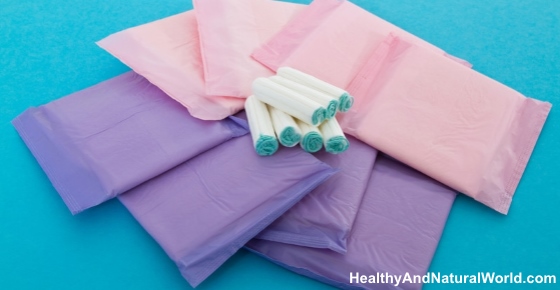What’s Really in Your Sanitary Pads and Tampons? Inc. Video

There has been an enduring debate about the use of feminine hygiene products to alleviate the burden of menstrual cycles. Do you use pads, or are tampons a better option? What if you found out that either choice could be harmful to your health? You might think that since they are marketed as “hygiene products” then they would be a completely safe and healthy choice, and it’s completely understandable to assume so.
Retailers around the world have stocked their shelves with them. Dominate marketing campaigns, praising “protection” and “health”, have completely overshadowed the safe alternatives for menstrual maintenance.
Possible Health Implications
So what exactly is the issue with these seemingly safe products, and why are some doctors referring to them as “ticking time bombs”? A general overview of what they are made out of might reveal a bit of insight to this question.
A person might expect these white, fluffy and innocent looking products to be made of nothing but safe cotton and harmless materials. In reality there is cotton, but it is mixed with toxic plastics and wood fluff pulp that are used to imitate the soft appearance, absorbency and texture of pure cotton:
Rayon – This is a regenerated cellulose fiber that is not uncommon to find within tampons in the U.S. Wood pulp is ran through a bleaching process to manufacture the fibers for use in products.
Viscose – A type of wood cellulose that is ran through a similar manufacturing process for use, used mainly for its soft feel in feminine hygiene products.
Fluff Pulp – This material comes after manufacturing wood from trees and is mainly used as an absorbent filler to pads.
The major controversy stemming from the use of these ingredients is tied to their superior absorbency. With tampons, the fibers can stick to fluids within the vaginal wall and remain in the body upon removal of the product, and that can cause vaginal infections.
Another controversy is tied to the use of chlorine when bleaching the fibers used in tampons and pads. Dioxin is the toxic result of this process, and poses some serious threats to women’s health.
Dioxin is a pressing issue within the topic of industrial pollution, and is linked to an array of health problems. It is stored for long amounts of time within body fat and can lead to delayed pregnancy development, cancer, and a range of diseases.
Other problems with dioxin are the irregular development of tissue and cells within the reproductive system, weakened immune system, and disturbance of hormone production – all are side effects of dioxin, as studies have shown.
The rise in bacterial growth that results from some mass produced tampons might also lead to an increased risk of toxic shock syndrome. Poisonous toxins worsen and can develop to become potentially life-threatening.
Healthy and Safe Alternatives
It’s no surprise that once again, the public has been mass marketed a product without an in depth consideration of health implications. Why would major companies that are mass producing these products care? They are making hundreds of millions of dollars each year in the U.S. alone.
As a matter of fact, the U.S. has recently surpassed the billion dollar mark in annual profits with sanitary napkin and tampon sales.
This doesn’t mean that women have to go without hygiene products during their period, as there are plenty of alternative options that are completely safe.
Here are some tips:
1. If you don’t want to veer from the use and effectiveness of tampons, try searching for a brand that uses safe and natural products. There are many different organic options that use non genetically modified cotton and minimal plastic. These are most likely not the huge name brand products either, as they have been mass produced for profit, not quality.
2. When examining the label, keep your eyes peeled for a product that is chlorine and bleach free. Also, try to stay clear of brands that use chemical scenting agents.
3. The same approach can be taken with the use of sanitary pads. There are several brands of pads out there that use a similar organic manufacturing to ensure the livelihood of women. Certain brands of pads aren’t made to be disposable at all. They use a comfortable, washable material that use varied thickness to address varied levels of flow.
4. A menstrual cup is another great, safe and under-appreciated option for health conscious women. The silicon cup is crafted to flex and fit comfortably within the vagina. The cup must be emptied, washed and reinserted at least twice a day.
The main incentive to this method is the evident benefit to the environment. Tons of waste product is dumped into landfills from tampons and pads every year and every woman that uses a cup is lowering that toll.
If the big tampon and pad companies were in business for the interest of women, why would they be so shady about their product’s health implications? There are several petitions in circulation aimed at exposing this overlooked aspect of feminine hygiene products by forcing the major companies to stop hiding ingredients and list all of the materials used.
Women should take an authoritative stand against any brand exploiting them. Having to deal with the monthly burden of a period is enough to deal with, they don’t need their health compromised for profit as well.
We need to take care of ourselves, and one of the common issues that women have is vaginal yeast infection. For natural treatments for yeast infection, read my article:
